Intel’s latest 10th-gen “Comet Lake S” desktop processors solve the hyperthreading issues that plagued Intel’s 9th-gen chips, with a unique wrinkle: the ability to dial hyperthreading on and off on a per-core basis. The fastest of the thirty-two new chips pushes clock speeds up to 5.3GHz, though that’s specific to a single core. Intel boasts the 10-core/20-thread Core i9-10900K will be the world’s fastest gaming processor, a claim that we’re eager to test.
Also in the mix are two derivatives Intel’s offered previously: specific F-series parts that lack integrated GPU cores, as well as ten T-series 35W chips optimized for small-form-factor designs.
Though overall base clock speeds appear to be higher than those offered in the Coffee Lake-R chips we saw a year ago, however, don’t be fooled by the 10th-gen nomenclature. These are still 14nm parts, with the same UHD 630 integrated GPU as the prior generation. Comet Lake S will also require new LGA 1200 socket motherboards to accommodate TDP power that has climbed to 125W in places.
Intel’s promising double-digit performance increases when Comet Lake is compared to the 9th-gen Coffee Lake, and substantially more versus an older PC. The real question, of course, is whether Intel’s new Comet Lake chips will be able to up-end AMD’s world-beating 16-core Ryzen 3950X desktop chip and its Threadripper counterparts, the 32-core 3970X and 64-core 3990X. Not surprisingly, Intel’s emphasis is on the need for single-core performance, its traditional area of strength.
 Intel
IntelA list of some of the new features within the Intel Comet Lake desktop platform
Comet Lake S: The chips themselves
Brandt Guttridge, Intel’s senior director for desktop and workstation product marketing, explained that Intel is seeking to improve clock speed, tunability, and real-world performance. Intel didn’t say as much, but some of what Intel is offering appears to try and minimize its power disadvantage relative to Ryzen, while maximizing Comet Lake’s time in turbo mode to push performance higher.
The Core i9-10900K lists for the same price as the Core i9-9900K did, initially: $488, though the $262 Intel is charging for the Core i5-10600K 6-core/12-thread part may attract more buyers. You’ll notice, though, that the power consumption of many of these new chips now touch 125W, versus the 95W consumed by many 9th-gen chips. (AMD’s Ryzen 9 3950X consumes 105W, though it’s priced at over $700 on Amazon; the 105W Ryzen 9 3900X costs $409.)
Intel will also continue to sell F-series versions of the Comet Lake processors. The F-series chips ship with the integrated graphics disabled, requiring customers to use a discrete GPU instead. They’re cheaper, but they also allow Intel to sell a CPU whose integrated graphics fails testing, producing more revenue for the company.
The screen below lists Intel’s 17 new Core i9, Core i7, Core i5, and Core i3 Comet Lake parts. Several come unlocked (with K suffixes), allowing overclockers to push clock speeds even higher. Guttridge said that Intel sells from four million to five million unlocked processors per year, “a fairly significant chunk of our overall market.”
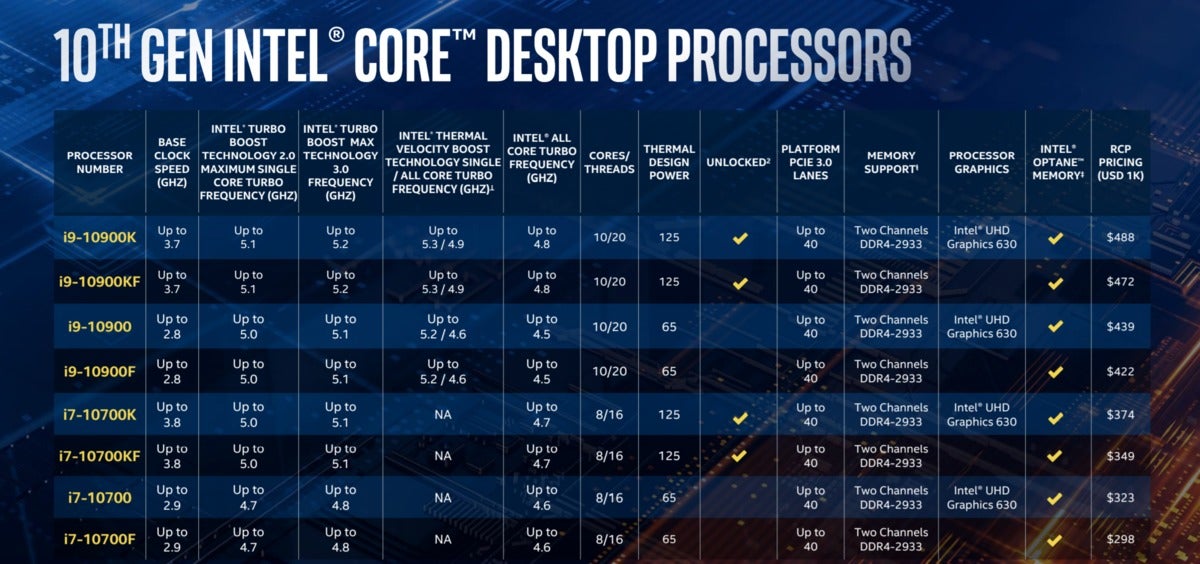 Intel
Intel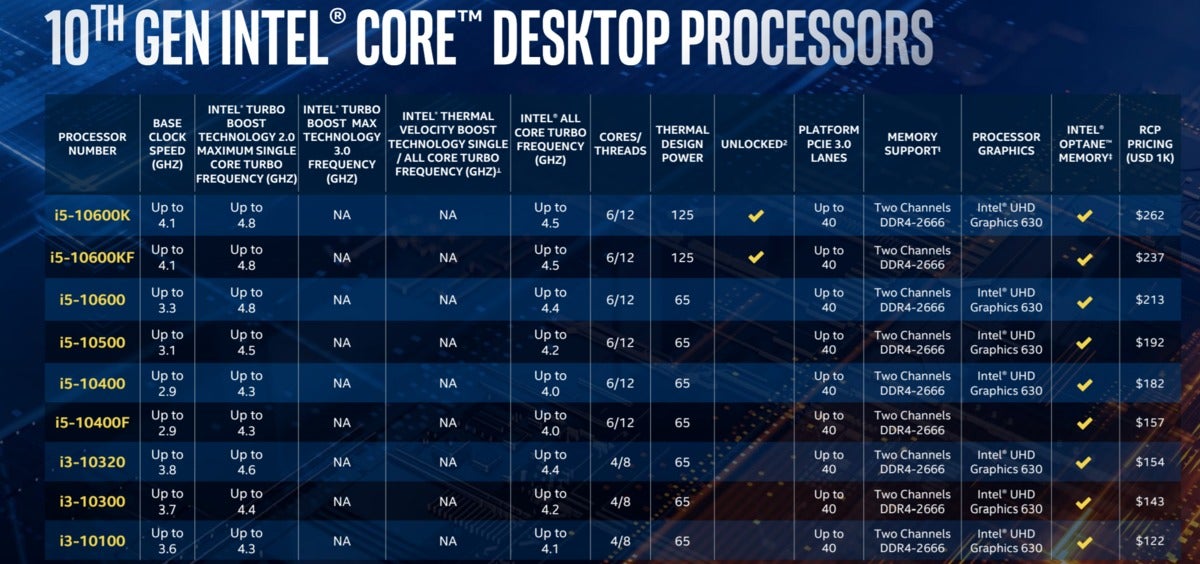 Intel
IntelIntel now provides much more information regarding the turbo-boost capabilities of the new chips. In this generation, Intel has migrated to Turbo Boost Max Technology 3.0, which debuted in 2016 inside a $1,700 Broadwell-E gaming CPU and then with the Cascade Lake-X desktop chips. In those two chip families, Turbo Boost Max Technology 3.0 selected a single “favored” core that it knew it could safely overclock. Within the Comet Lake chip family, the same technology selects not one, but two favored cores to be accelerated using the turbo boost capability, with no increase in applied voltage, Guttridge explained.
Likewise, the highest-end chips support Thermal Velocity Boost, also found in the recent Comet Lake-H mobile chips. In each, TVB works with thermal sensors elsewhere in the system to tack on 200MHz of additional speed if the system can accommodate it, up to 70 degrees Centigrade. If you’re interested in a Core i5 or below, however, all those turbo capabilities go away.
An Intel representative said that the UHD630 graphics core runs at 350MHz, boosting to 1.2GHz if needed. The exceptions lie in some Core i5 processors, where the dynamic boost speed falls slightly to 1.15GHz or 1.10GHz speeds. (Intel’s 9th-gen cores used the UHD630, too.)
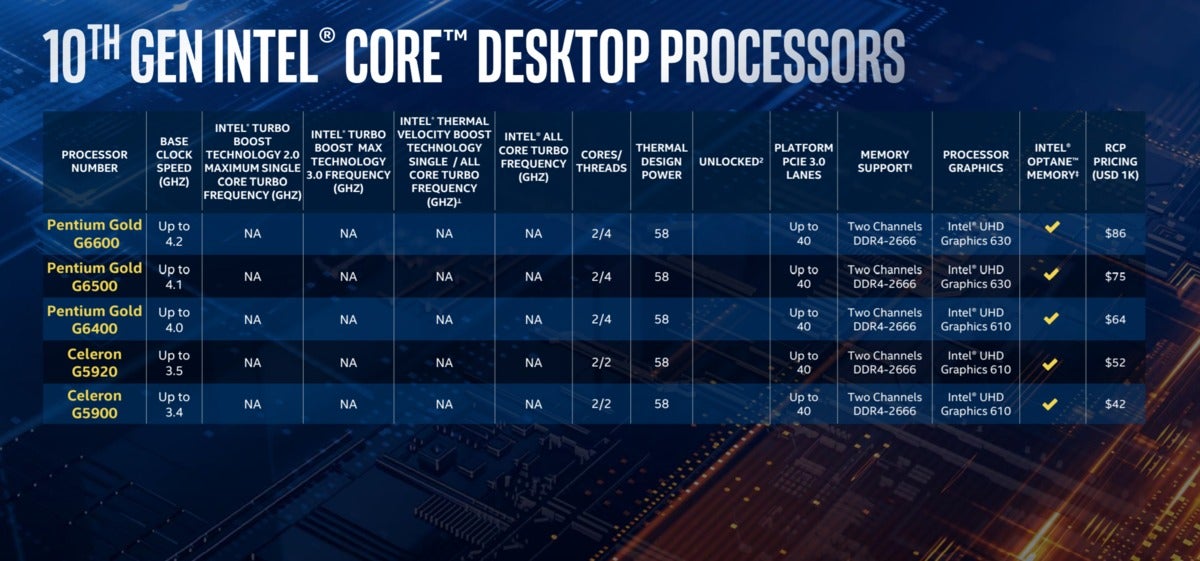 Intel
IntelIntel’s low-end Comet Lake desktop parts
Intel also has a series of cheaper 58W parts for lower-cost systems, consisting of the Pentium Gold family. Only the lowest of the low-end Celeron chips lack hyperthreading.
Finally, Intel also will offer a number of T-series Comet Lake desktop chips, presumably for NUCs and other small-form-factor devices. These 35W chips do include a Core i7 model and even a Core i9, together with some of the turbo advantages that the other chips offer. They’re not all that cheap, either.
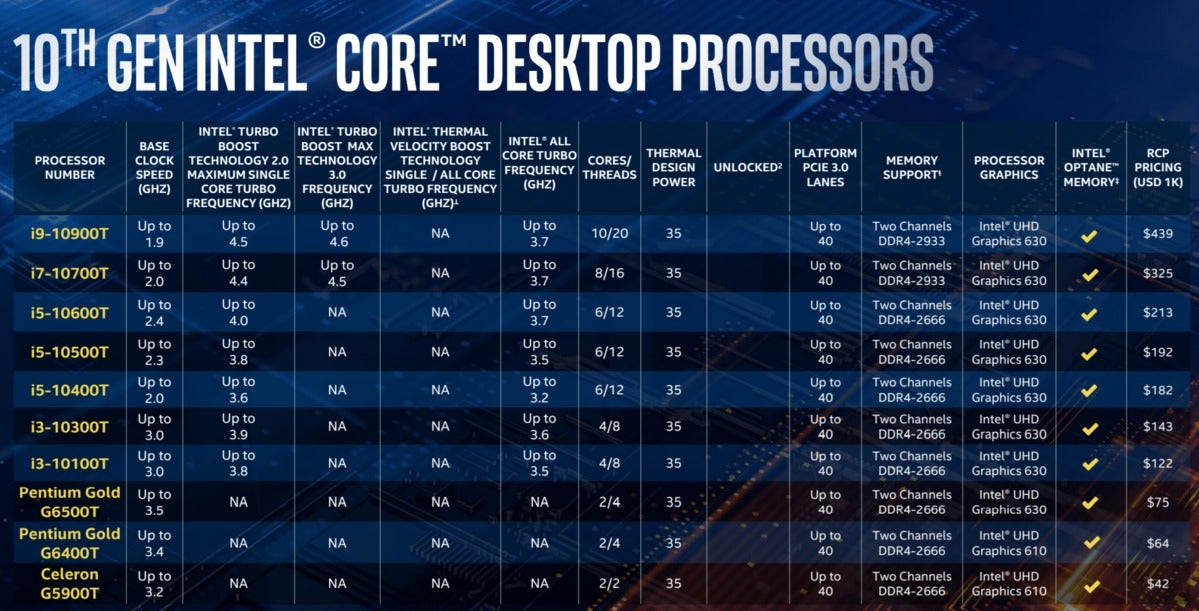 Intel
IntelThe Comet Lake T-series parts consume less power, and are designed for small-form-factor and other space-constrained systems.
Intel’s Comet Lake performance estimates
In terms of performance, Intel isn’t shying away from AMD’s recent announcements. Intel’s claim that the Core i9-10900K is the “world’s fastest gaming processor” includes the Ryzen 3950X. In a footnote attached to Intel’s presentation, Intel indicates that all of the systems were configured identically, though the configurations don’t list the chipset Intel used. “[The] 10th Gen Intel Core i9-10900K scored better on the majority of the 25+ game titles tested,” Intel claims, which include Assassin’s Creed: Odyssey, Far Cry: New Dawn, Hitman 2, Rocket League, Shadow of the Tomb Raider, Strange Brigade, and more.
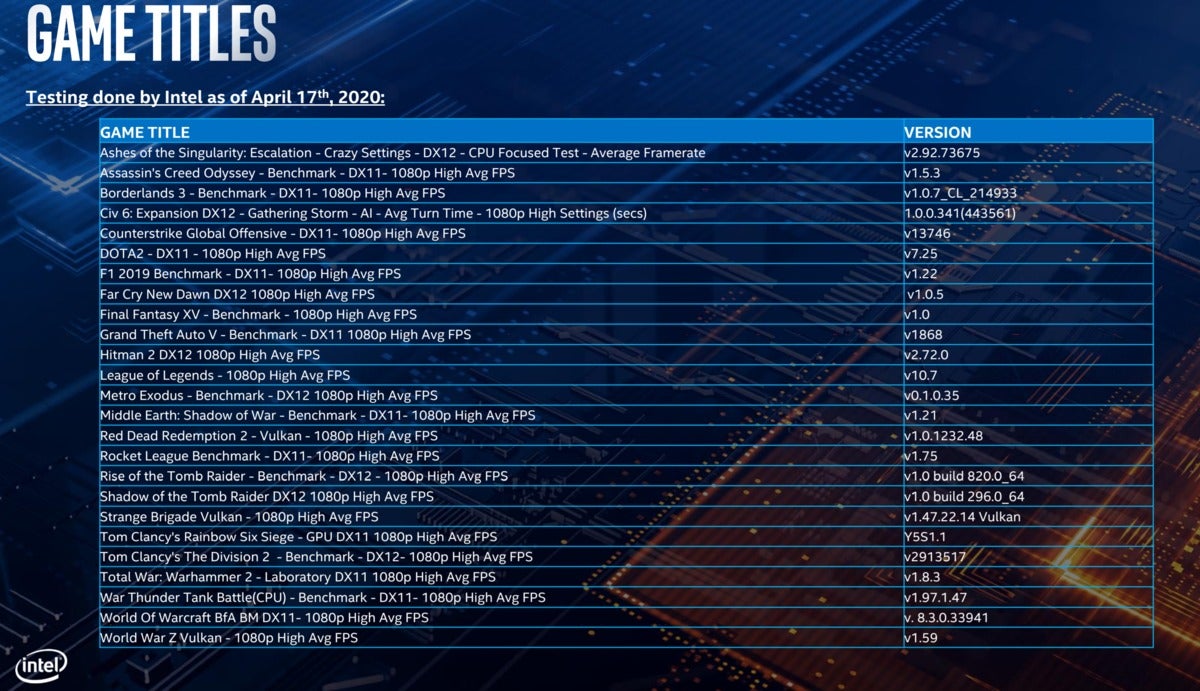 Intel
IntelA list of games Intel used to justify claim that the Core i9-10900K is the world’s fastest gaming processor. Note: Intel made the claim based on the fact that its chips won a “majority” of these benchmarks.
For about a year, Intel has challenged AMD to use real-world performance metrics rather than artificial benchmarks. That’s held true here as well: Intel selected a number of different games and compared its new Comet Lake chips against the previous generation Core i9-9900K as well as the Core i7-7700K, with all three systems powered by an Nvidia RTX 2080Ti. Generation-over-generation gameplay improvements range from 10 to 33 percent, with 18 percent faster 4K video editing. Compared to the Core i7-7700K, performance improved from 37 percent to 81 percent, with a 35-percent boost in video editing.
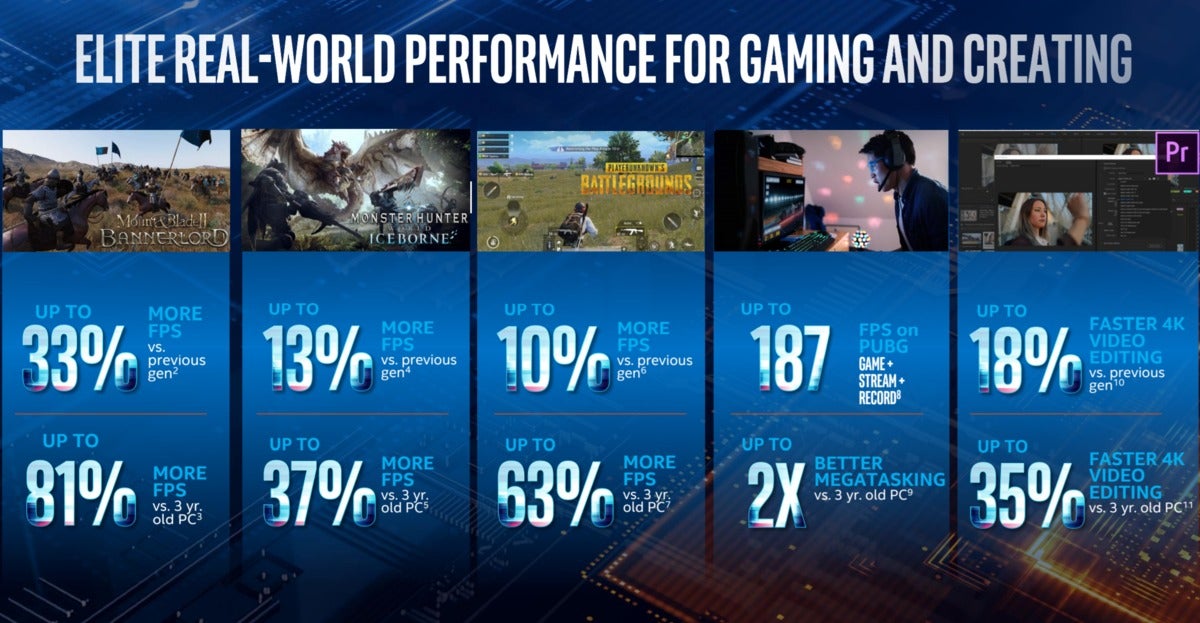 Intel
IntelIntel’s self-evaluation of Comet Lake S performance.
Intel’s decision to push frequencies across a limited number of cores, Guttridge said, is based on its own research. “Ninety-five percent of systems that are connecting to Steam, based on our internal research, are using six cores or below,” he said. “So it’s a relatively large base of a relatively small to medium core count, however you want to define that. So the frequency on those critical six cores is a huge factor in delivering performance.”
Pushing it further: Overclocking Comet Lake S
One of the most interesting features within the new desktop Comet Lake chips is the ability to turn off hyperthreading on a per-core basis, something Intel or AMD hasn’t provided anywhere else.
Why do this, especially when Intel’s 9th-gen desktop chips lacked such features? According to Guttridge, Intel did so for reasons of control: allowing you to disable hyperthreading on cores that aren’t being used allows more fine-grained control. More important, however, is power: By disabling hyperthreading on cores that aren’t being used, the processor generates less heat. Less heat means that the cores that are being used can remain in turbo mode for longer periods, generating more performance overall.
“Heat, as most of you know, is our enemy in terms of performance,” Guttridge said. “We don’t want to generate heat, or if we do, we want to get it out of the processor as fast as possible.”
Secondly, Intel will allow users to overclock the PCIe lanes out of the CPU (the PEG interface) as well as the DMI 3.0 interface between the CPU and the chipset. Overclocking the PEG bus will allow for better throughput to and from system-level devices like graphics cards, Guttridge said. Overclocking DMI can result in some performance improvements with heavy DMI loading, an Intel spokesman added. However, PEG and DMI overclocking is considered an optional feature, and will vary by board, he said.
Intel will provide what it’s calling enhanced voltage and frequency curve controls. The company will also refresh its Extreme Tuning Utility (XTU) to take advantage of “new features,” though not the per-core hyperthreading toggle. A spokesman said that the toggle will be exposed in the BIOS if overclocking is enabled. Features like per-core hyperthreading will be provided to system-level tools provided by board and system makers, Intel executives said, and will apparently vary.
“Per-core hyperthreading control is exposed through the BIOS, as this change is not possible on-the-fly in Windows/XTU,” according to an Intel spokesman. “PEG/DMI overclocking is exposed through BIOS because it is motherboard specific. Each motherboard partner uniquely selects their own discrete clock generator vendor and part numbers.”
While the voltage controls are exposed to XTU, overclockers are advised to check with the motherboard vendor to see if they offer their own overclocking software interface for PEG/DMI control, the spokesman added.
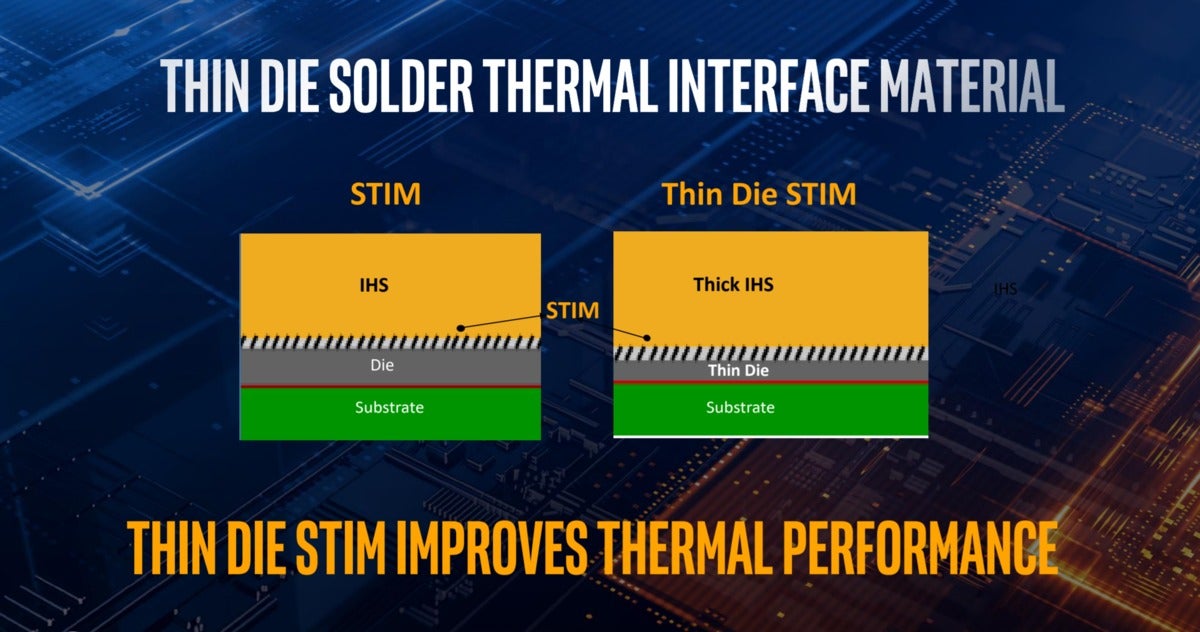 Intel
IntelIntel thinned the Comet Lake die, adding more copper to assist cooling.
The Comet Lake design also includes a thinner die STIM, or solder thermal interface material. The Z-height of the CPU itself isn’t changing, which would affect how heat sinks and coolers would fit. What Intel is doing, however, is thinning the silicon die which acts as a thermal insulator, and thickening the integrated heat spreader (IHS) instead. (The reduction is about 300 micrometers, down to 500 micrometers.) The additional copper should help migrate heat out of the CPU, again allowing it to remain for longer periods in turbo mode, Guttridge said.
Intel also still has its Performance Tuning Protection “insurance” plan in place, Intel executives added.
Four new chipsets accompany Comet Lake S
Unfortunately, the new LGA 1200 socket will require a new motherboard for those seeking to upgrade from the older 9th-gen parts. Intel has disclosed four chipsets to support the new Comet Lake desktop hardware, including the Z490, which appears to be a Comet Lake-optimized version of the Z390, and the H470. Intel has disclosed that the B460 and the H410 will also be available, presumably for more budget-oriented systems.
Here, the most significant upgrade is likely memory. Intel has moved from DDR4-2666 on the Z390 to supporting dual-channel DDR4-2933, with two DIMMs apiece available on either channel. Enthusiasts weighing a move to Ryzen will be disappointed to learn that Intel has remained on PCI Express 3.0. Thunderbolt isn’t listed as an option on any of the chipset documentation we’ve seen.
Z490 specs
The Z490 chipset appears to be the premium offering, with the most options: sixteen PCIe 3.0 lanes off the CPU (in 1×16, 2×8, or 1×8+2×4 configurations) and twenty-four more off of the chipset. The same DMI 3.0 interface is used to connect the processor to the chipset in both the Z490 and H470.
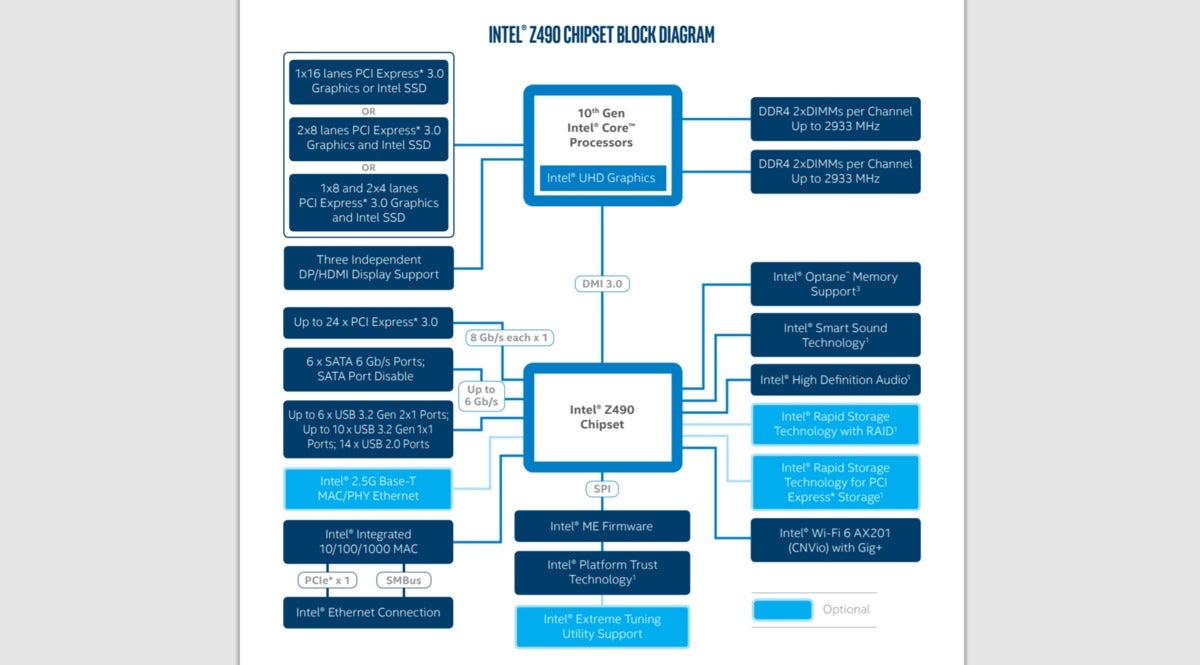 Intel
IntelIntel’s Z490 appears to be the premium chipset option with Comet Lake.
Motherboard makers designing Z490 boards also have the options of six USB 3.2 Gen2x1 ports, ten USB 3.2 Gen 1×1 ports, or fourteen USB 2.0 ports. There are six 6Gbps SATA ports, too. Other optional features include Intel’s 2.5G ethernet i219-V and RapidStorage support for RAID 0, 1, and 5.
Of the three chipsets, the Z490 is the only one to list CPU and memory overclocking as an option.
H470 specs
The H470 offers just 1×16 PCIe 3.0 off the CPU, and twenty more off of the chipset. In the H470, board makers may choose among four USB 3.2 Gen 2×1 ports, four USB 3.2 Gen 1×1 ports, and fourteen USB 2.0 ports. Six 6Gbps SATA ports are also available, and Intel’s 2.5G ethernet and RapidStorage RAID are still both options.
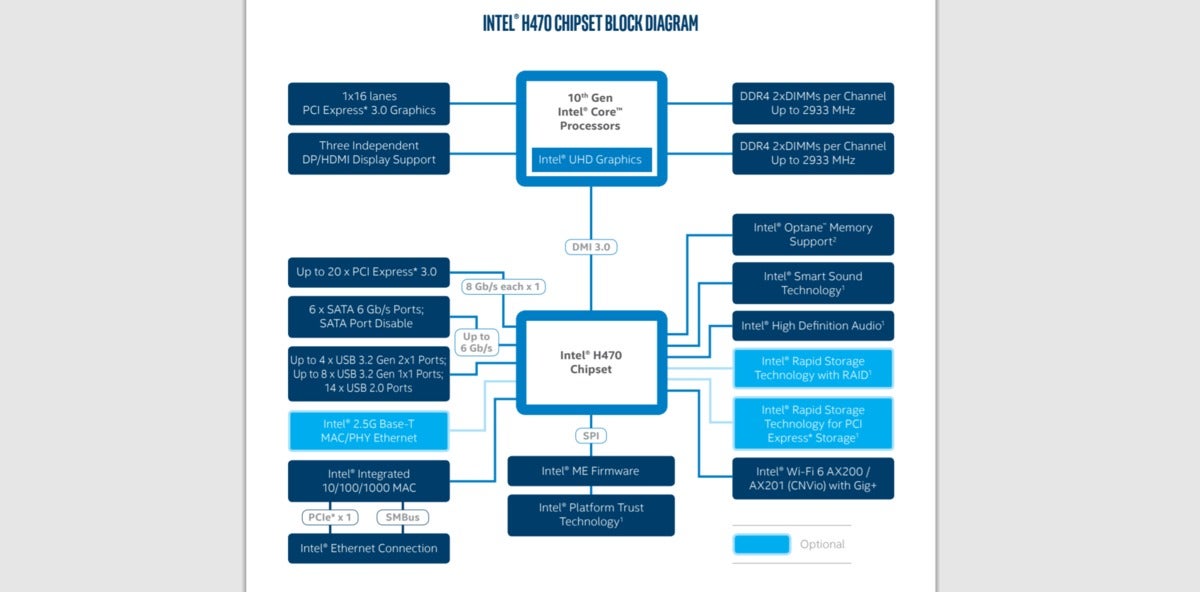 Intel
IntelWe don’t really know the price of H470 boards, though they’ll offer less than what the Z490 boards do.
B460 specs
Like the H470, the B460 chipset allows for sixteen lanes of PCI Express 3.0 off the microprocessor, in a 1×16 configuration. An additional sixteen lanes of PCIe 3.0 hang off the chipset. There are six 6Gbps SATA ports, along with the option of either eight USB 3.2 Gen 1×1 ports, or twelve USB 2.0 ports.
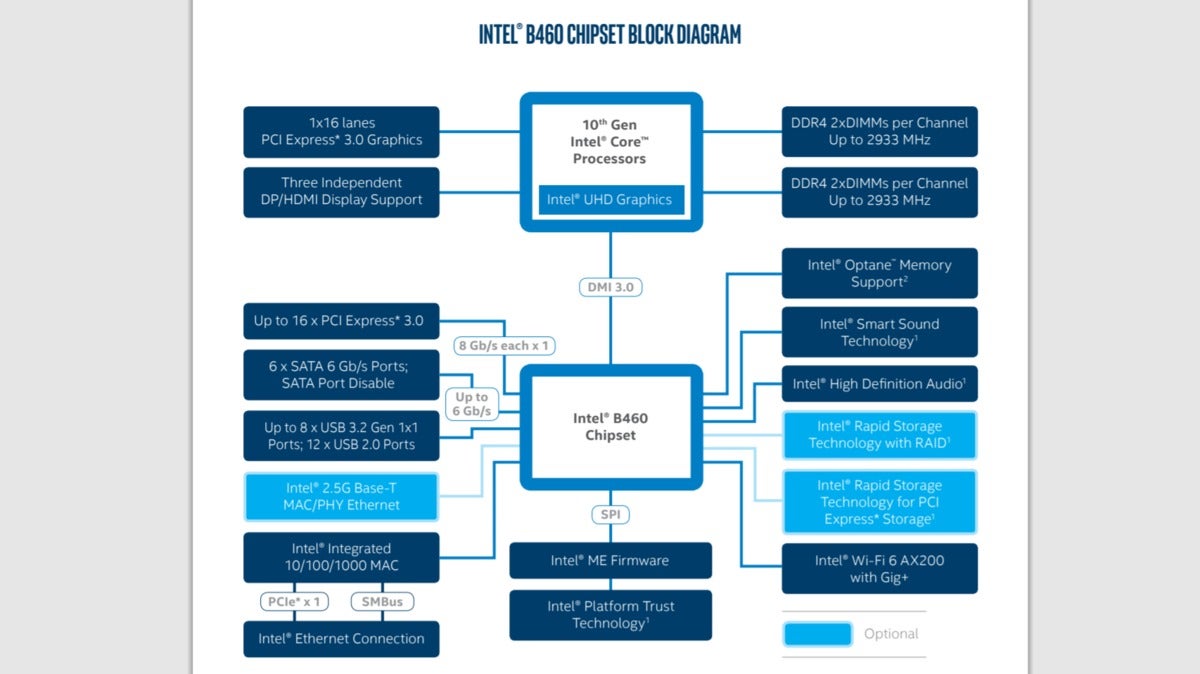 Intel
IntelIntel’s B460 chipset appears to be a true budget part.
All three chipsets, however, include Intel’s Wi-Fi 6 AX201 (CNVio) with Gig+, which debuted accompanying Ice Lake. Wi-Fi 6 Gig+ increases the size of the available channels to 160MHz, allowing a total bandwidth of 1.68 gigabits per second. They all support Optane Memory, too.
Documentation on the H410 wasn’t available at press time.
Intel’s making bold claims about how well its new Comet Lake S chips can stack up to Ryzen, especially with the impressive, recent performance of both Ryzen 9 chips. Can Intel hold on to its gaming lead, and do so without breaking users’ budgets? We hope to have some of these answers soon.












